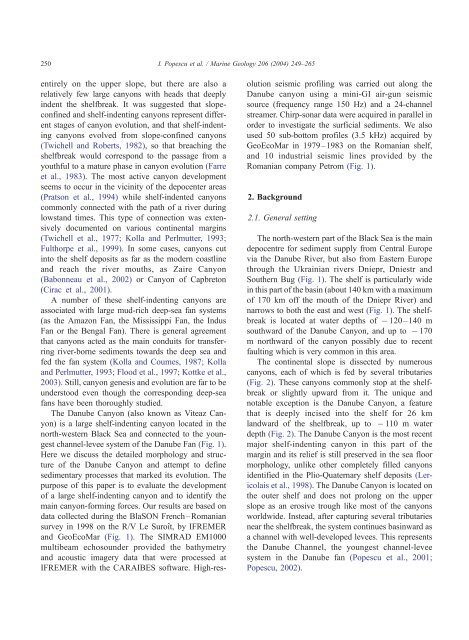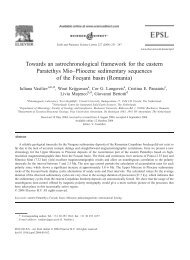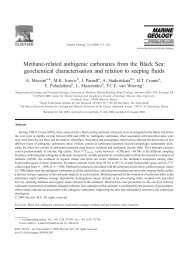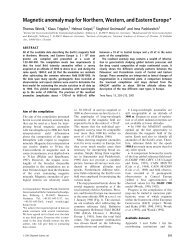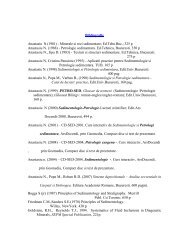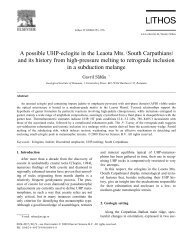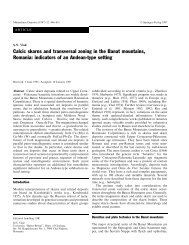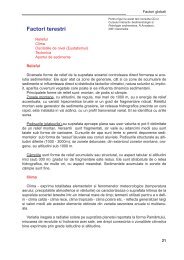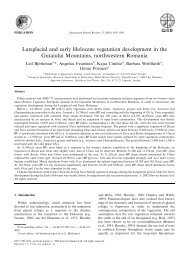The Danube submarine canyon (Black Sea ... - geo.edu.ro
The Danube submarine canyon (Black Sea ... - geo.edu.ro
The Danube submarine canyon (Black Sea ... - geo.edu.ro
Create successful ePaper yourself
Turn your PDF publications into a flip-book with our unique Google optimized e-Paper software.
250<br />
I. Popescu et al. / Marine Geology 206 (2004) 249–265<br />
entirely on the upper slope, but there are also a<br />
relatively few large <st<strong>ro</strong>ng>canyon</st<strong>ro</strong>ng>s with heads that deeply<br />
indent the shelfbreak. It was suggested that slopeconfined<br />
and shelf-indenting <st<strong>ro</strong>ng>canyon</st<strong>ro</strong>ng>s represent different<br />
stages of <st<strong>ro</strong>ng>canyon</st<strong>ro</strong>ng> evolution, and that shelf-indenting<br />
<st<strong>ro</strong>ng>canyon</st<strong>ro</strong>ng>s evolved f<strong>ro</strong>m slope-confined <st<strong>ro</strong>ng>canyon</st<strong>ro</strong>ng>s<br />
(Twichell and Roberts, 1982), so that breaching the<br />
shelfbreak would correspond to the passage f<strong>ro</strong>m a<br />
youthful to a mature phase in <st<strong>ro</strong>ng>canyon</st<strong>ro</strong>ng> evolution (Farre<br />
et al., 1983). <st<strong>ro</strong>ng>The</st<strong>ro</strong>ng> most active <st<strong>ro</strong>ng>canyon</st<strong>ro</strong>ng> development<br />
seems to occur in the vicinity of the depocenter areas<br />
(Pratson et al., 1994) while shelf-indented <st<strong>ro</strong>ng>canyon</st<strong>ro</strong>ng>s<br />
commonly connected with the path of a river during<br />
lowstand times. This type of connection was extensively<br />
documented on various continental margins<br />
(Twichell et al., 1977; Kolla and Perlmutter, 1993;<br />
Fulthorpe et al., 1999). In some cases, <st<strong>ro</strong>ng>canyon</st<strong>ro</strong>ng>s cut<br />
into the shelf deposits as far as the modern coastline<br />
and reach the river mouths, as Zaire Canyon<br />
(Babonneau et al., 2002) or Canyon of Capbreton<br />
(Cirac et al., 2001).<br />
A number of these shelf-indenting <st<strong>ro</strong>ng>canyon</st<strong>ro</strong>ng>s are<br />
associated with large mud-rich deep-sea fan systems<br />
(as the Amazon Fan, the Mississippi Fan, the Indus<br />
Fan or the Bengal Fan). <st<strong>ro</strong>ng>The</st<strong>ro</strong>ng>re is general agreement<br />
that <st<strong>ro</strong>ng>canyon</st<strong>ro</strong>ng>s acted as the main conduits for transferring<br />
river-borne sediments towards the deep sea and<br />
fed the fan system (Kolla and Coumes, 1987; Kolla<br />
and Perlmutter, 1993; Flood et al., 1997; Kottke et al.,<br />
2003). Still, <st<strong>ro</strong>ng>canyon</st<strong>ro</strong>ng> genesis and evolution are far to be<br />
understood even though the corresponding deep-sea<br />
fans have been tho<strong>ro</strong>ughly studied.<br />
<st<strong>ro</strong>ng>The</st<strong>ro</strong>ng> <st<strong>ro</strong>ng>Danube</st<strong>ro</strong>ng> Canyon (also known as Viteaz Canyon)<br />
is a large shelf-indenting <st<strong>ro</strong>ng>canyon</st<strong>ro</strong>ng> located in the<br />
north-western <st<strong>ro</strong>ng>Black</st<strong>ro</strong>ng> <st<strong>ro</strong>ng>Sea</st<strong>ro</strong>ng> and connected to the youngest<br />
channel-levee system of the <st<strong>ro</strong>ng>Danube</st<strong>ro</strong>ng> Fan (Fig. 1).<br />
Here we discuss the detailed morphology and structure<br />
of the <st<strong>ro</strong>ng>Danube</st<strong>ro</strong>ng> Canyon and attempt to define<br />
sedimentary p<strong>ro</strong>cesses that marked its evolution. <st<strong>ro</strong>ng>The</st<strong>ro</strong>ng><br />
purpose of this paper is to evaluate the development<br />
of a large shelf-indenting <st<strong>ro</strong>ng>canyon</st<strong>ro</strong>ng> and to identify the<br />
main <st<strong>ro</strong>ng>canyon</st<strong>ro</strong>ng>-forming forces. Our results are based on<br />
data collected during the BlaSON French–Romanian<br />
survey in 1998 on the R/V Le Su<strong>ro</strong>ît, by IFREMER<br />
and GeoEcoMar (Fig. 1). <st<strong>ro</strong>ng>The</st<strong>ro</strong>ng> SIMRAD EM1000<br />
multibeam echosounder p<strong>ro</strong>vided the bathymetry<br />
and acoustic imagery data that were p<strong>ro</strong>cessed at<br />
IFREMER with the CARAIBES software. High-resolution<br />
seismic p<strong>ro</strong>filing was carried out along the<br />
<st<strong>ro</strong>ng>Danube</st<strong>ro</strong>ng> <st<strong>ro</strong>ng>canyon</st<strong>ro</strong>ng> using a mini-GI air-gun seismic<br />
source (frequency range 150 Hz) and a 24-channel<br />
streamer. Chirp-sonar data were acquired in parallel in<br />
order to investigate the surficial sediments. We also<br />
used 50 sub-bottom p<strong>ro</strong>files (3.5 kHz) acquired by<br />
GeoEcoMar in 1979–1983 on the Romanian shelf,<br />
and 10 industrial seismic lines p<strong>ro</strong>vided by the<br />
Romanian company Pet<strong>ro</strong>m (Fig. 1).<br />
2. Backg<strong>ro</strong>und<br />
2.1. General setting<br />
<st<strong>ro</strong>ng>The</st<strong>ro</strong>ng> north-western part of the <st<strong>ro</strong>ng>Black</st<strong>ro</strong>ng> <st<strong>ro</strong>ng>Sea</st<strong>ro</strong>ng> is the main<br />
depocentre for sediment supply f<strong>ro</strong>m Central Eu<strong>ro</strong>pe<br />
via the <st<strong>ro</strong>ng>Danube</st<strong>ro</strong>ng> River, but also f<strong>ro</strong>m Eastern Eu<strong>ro</strong>pe<br />
th<strong>ro</strong>ugh the Ukrainian rivers Dniepr, Dniestr and<br />
Southern Bug (Fig. 1). <st<strong>ro</strong>ng>The</st<strong>ro</strong>ng> shelf is particularly wide<br />
in this part of the basin (about 140 km with a maximum<br />
of 170 km off the mouth of the Dniepr River) and<br />
nar<strong>ro</strong>ws to both the east and west (Fig. 1). <st<strong>ro</strong>ng>The</st<strong>ro</strong>ng> shelfbreak<br />
is located at water depths of 120–140 m<br />
southward of the <st<strong>ro</strong>ng>Danube</st<strong>ro</strong>ng> Canyon, and up to 170<br />
m northward of the <st<strong>ro</strong>ng>canyon</st<strong>ro</strong>ng> possibly due to recent<br />
faulting which is very common in this area.<br />
<st<strong>ro</strong>ng>The</st<strong>ro</strong>ng> continental slope is dissected by nume<strong>ro</strong>us<br />
<st<strong>ro</strong>ng>canyon</st<strong>ro</strong>ng>s, each of which is fed by several tributaries<br />
(Fig. 2). <st<strong>ro</strong>ng>The</st<strong>ro</strong>ng>se <st<strong>ro</strong>ng>canyon</st<strong>ro</strong>ng>s commonly stop at the shelfbreak<br />
or slightly upward f<strong>ro</strong>m it. <st<strong>ro</strong>ng>The</st<strong>ro</strong>ng> unique and<br />
notable exception is the <st<strong>ro</strong>ng>Danube</st<strong>ro</strong>ng> Canyon, a feature<br />
that is deeply incised into the shelf for 26 km<br />
landward of the shelfbreak, up to 110 m water<br />
depth (Fig. 2). <st<strong>ro</strong>ng>The</st<strong>ro</strong>ng> <st<strong>ro</strong>ng>Danube</st<strong>ro</strong>ng> Canyon is the most recent<br />
major shelf-indenting <st<strong>ro</strong>ng>canyon</st<strong>ro</strong>ng> in this part of the<br />
margin and its relief is still preserved in the sea floor<br />
morphology, unlike other completely filled <st<strong>ro</strong>ng>canyon</st<strong>ro</strong>ng>s<br />
identified in the Plio-Quaternary shelf deposits (Lericolais<br />
et al., 1998). <st<strong>ro</strong>ng>The</st<strong>ro</strong>ng> <st<strong>ro</strong>ng>Danube</st<strong>ro</strong>ng> Canyon is located on<br />
the outer shelf and does not p<strong>ro</strong>long on the upper<br />
slope as an e<strong>ro</strong>sive t<strong>ro</strong>ugh like most of the <st<strong>ro</strong>ng>canyon</st<strong>ro</strong>ng>s<br />
worldwide. Instead, after capturing several tributaries<br />
near the shelfbreak, the system continues basinward as<br />
a channel with well-developed levees. This represents<br />
the <st<strong>ro</strong>ng>Danube</st<strong>ro</strong>ng> Channel, the youngest channel-levee<br />
system in the <st<strong>ro</strong>ng>Danube</st<strong>ro</strong>ng> fan (Popescu et al., 2001;<br />
Popescu, 2002).


